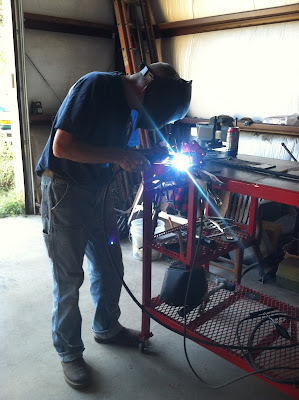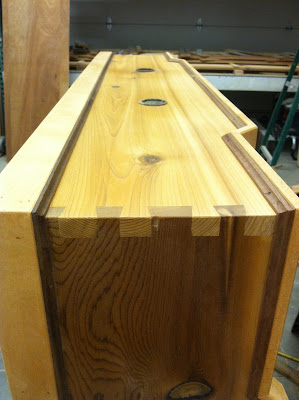A few years ago, I started construction on a router table for my shop, modeled after the one built by Norm Abrams on the TV series New Yankee Workshop. The plans are available for purchase, but I wanted to see what I could come up with on my own.
The design calls for the whole thing to be connected to dust collection, which is a big plus. Anyone who's ever spent much time with a router can tell you that they make A LOT of dust. Seriously.
I finished building the cabinet three years ago, figuring that when I got time, I'd complete the face frames, drawers, handles, and main compartment door.
So this is how I've been using it ever since- and even without a main door, dust collection still works fairly well.
sizing up the drawers
Cutting the slot for the drawer bottom on one of the drawer pieces. Got a little chewed up...
...and here's why. The opening for the router bit on the table makes it unsafe for cutting small pieces. They have a tendency to fall into the gap- super dangerous to anyone who likes having all their fingers.
The solution was to take the pieces over to the table saw and make a series of saw kerf cuts just deep and wide enough to accept the drawer bottom.
Here's the not yet finished product- stack of drawers ready for test fitting.
Obviously I only did the top six drawers here- as seen in their new homes here. I didn't want to build the other drawers until I had the face frame on- (the face frame is what covers up the plywood cabinet carcass- look at your cabinets in your kitchen and you'll know what I mean: it's the "pretty" face of wood you see that's not a drawer.)
Walnut boards waiting to become face frames. Quivering with excitement. I wanted dark walnut as the backdrop to create a little contrast with the lighter maple drawer fronts I was planning on installing.
Here, I'm using a specialty tool for joining cabinet face frame members, called a Kreg Jig- it drills a diagonal hole in the end of one piece, than you use a special screw to attach it to the joining member. I bought this jig 2 years ago just for this purpose... and immediately screwed it up. So I ditched the idea and went right to nailing the face frames on through the face of the pieces...
...and here's the end result of face frames going on. Even without finish, it really cleans up the look of the cabinet.
Next was to mill some walnut for the main compartment door closure. I wanted to do a mortise and tenon style connection- these are the tenons (although I think REAL cabinet builders have an exact name for this style of joint.) In the next picture, these are the pieces holding in the Plexiglas window right in the center of the cabinet.
So I missed a few photos of making the drawer fronts and fitting them to the drawers. Oops. Sounds easy, but slightly more complicated in reality. Here they are halfway installed. Did the easy ones first, since they were all the same size.
Closeup, right before I called it a night. I love the way the soft maple has this great grain coloration. Most furniture builders would bypass it because of uniformity issues- but I take the other approach and try to make it a highlight.
I really didn't want to use some boring store bought handles for the larger drawers, so I used some of the leftovers from the drawer front stock. I wanted to keep with the characteristics of the wavy grain, so I went over to the band saw to rough out these handles...
...and then over to the spindle sander to round out the curves.
Made my own maple spacers...
Centered the handles, drilled some holes...
...and voila!
I love how organic the shape is- it just feels good to grab a handle that's out of the ordinary! One of my favorite parts is the character in this top left drawer front.
This is as much of an action shot as you can get with a cabinet!
All it needs now is a few coats of finish- but maybe in another three years I'll get back around to it.
And, if you haven't figured it out from my explanation yet- there's a router mounted upside down in the center portion of the cabinet (with the Plexiglas window) You can see the little cream colored router bit sticking up through the hole in the top.
2 main advantages of this setup- the dust collection/downdraft action keeps the worktop clean (not to mention the shop, and my lungs!) and it's much safer and consistent for running long material through when you need to put an edge on a board.
Case in point. I was asked to profile the edge of this oak board for a chair rail over at Rockin' Dave's Bagels here in Bend. (If you're in the area, I highly recommend checking it out! BTW, happy birthday Dave!!)
To cut the profile with a router would have been fairly precarious- trying to balance a wide router on a narrow and long board like this isn't the best way to go. So I just chucked the cove bit in the router table, hooked up dust collection, and fired it up. Easy Cheesy! A little sanding, and it was done.

































































